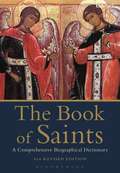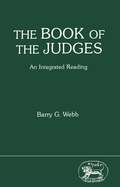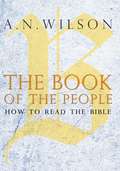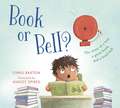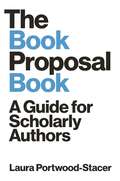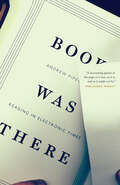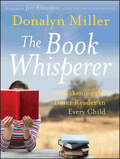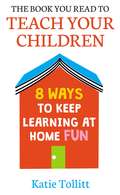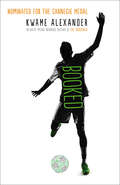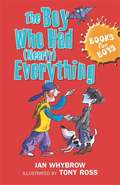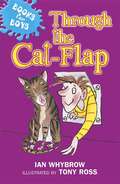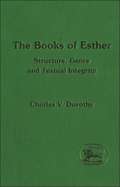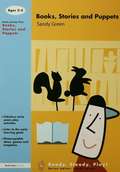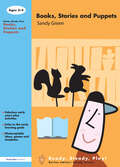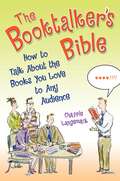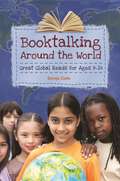- Table View
- List View
The Book of Saints: A Comprehensive Biographical Dictionary
by Basil WatkinsNow fully revised and updated The Book of Saints is a comprehensive biographical dictionary of saints canonised by the Roman Catholic Church. It contains the names of over 10,000 saints, including all modern ones, with significant information about their lives and achievements. Each section begins with an illustration of a particular saint, and the volume includes a list of national martyrs, a bibliography, and a helpful glossary.Produced by the Benedictine monks of St. Augustine's Abbey, Chilworth (formerly Ramsgate) this classic resource is now in its 8th edition, and is fully revised to include all the saints canonised in the last ten years, including Pope St John Paul II and Blessed Paul VI.
The Book of the Judges: An Integrated Reading (The Library of Hebrew Bible/Old Testament Studies)
by Barry G. WebbCovering topics that have only increased in relevance and urgency with time, this commentary by Barry Webb exhibits a thorough engagement with the text and themes of the Book of Judges. From the portrayal of women to the typology of relating the Old Testament to the New, Webb presents a clear and holistic reading of the text.
The Book of the People: How to Read the Bible
by A. N. WilsonIn The Book of the People A. N. Wilson explores how readers and thinkers have approached the Bible, and how it might be read today. Charting his own relationship with the Bible over a lifetime of writing, Wilson argues that it remains relevant even in a largely secular society, as a philosophical work, a work of literature and a cultural touchstone that the western world has answered to for nearly two thousand years. He challenges the way fundamentalists - whether believers or non-believers - have misused the Bible, either by neglecting and failing to recognize its cultural significance, or by using it as a weapon against those with whom they disagree. Erudite, witty and accessible, The Book of the People seeks to reclaim the Good Book as our seminal work of literature, and a book for the imagination.
The Book of Wonders: How Euclid's Elements Built The World
by Benjamin WardhaughEuclid’s Elements of Geometry was a book that changed the world. In a sweeping history, Benjamin Wardhaugh traces how an ancient Greek text on mathematics – often hailed as the world’s first textbook – shaped two thousand years of art, philosophy and literature, as well as science and maths.
Book or Bell?
by Chris BartonThe first page has Henry hooked.The second page has him captivated.The third page . . .BBBBRRRRIIIIINNNNNGGGGG!. . . will have to wait.That is, unless Henry ignores the bell, stays put, and keeps on reading the most awesome book.By not springing up with the ringing of the bell, Henry sets off a chain reaction unlike anything his school or town has ever seen. Luckily, Mayor Wise, Governor Bright, and Senator Brilliant know exactly what the situation calls for:A louder bell. MUCH louder.With this hilarious, high-energy satire from bestselling author Chris Barton and illustrator Ashley Spires, readers will be cheering louder still as one of their own continues to just stay put.
Book or Bell?
by Chris Barton Ashley SpiresThe first page has Henry hooked.The second page has him captivated.The third page . . .BBBBRRRRIIIIINNNNNGGGGG!. . . will have to wait.That is, unless Henry ignores the bell, stays put, and keeps on reading the most awesome book.By not springing up with the ringing of the bell, Henry sets off a chain reaction unlike anything his school or town has ever seen. Luckily, Mayor Wise, Governor Bright, and Senator Brilliant know exactly what the situation calls for:A louder bell. MUCH louder.With this hilarious, high-energy satire from bestselling author Chris Barton and illustrator Ashley Spires, readers will be cheering louder still as one of their own continues to just stay put.
The Book Proposal Book: A Guide for Scholarly Authors (Skills for Scholars)
by Laura Portwood-StacerA step-by-step guide to crafting a compelling scholarly book proposal—and seeing your book through to successful publicationThe scholarly book proposal may be academia’s most mysterious genre. You have to write one to get published, but most scholars receive no training on how to do so—and you may have never even seen a proposal before you’re expected to produce your own. The Book Proposal Book cuts through the mystery and guides prospective authors step by step through the process of crafting a compelling proposal and pitching it to university presses and other academic publishers.Laura Portwood-Stacer, an experienced developmental editor and publishing consultant for academic authors, shows how to select the right presses to target, identify audiences and competing titles, and write a project description that will grab the attention of editors—breaking the entire process into discrete, manageable tasks. The book features over fifty time-tested tips to make your proposal stand out; sample prospectuses, a letter of inquiry, and a response to reader reports from real authors; optional worksheets and checklists; answers to dozens of the most common questions about the scholarly publishing process; and much, much more.Whether you’re hoping to publish your first book or you’re a seasoned author with an unfinished proposal languishing on your hard drive, The Book Proposal Book provides honest, empathetic, and invaluable advice on how to overcome common sticking points and get your book published. It also shows why, far from being merely a hurdle to clear, a well-conceived proposal can help lead to an outstanding book.
The Book Proposal Book: A Guide for Scholarly Authors (Skills for Scholars)
by Laura Portwood-StacerA step-by-step guide to crafting a compelling scholarly book proposal—and seeing your book through to successful publicationThe scholarly book proposal may be academia’s most mysterious genre. You have to write one to get published, but most scholars receive no training on how to do so—and you may have never even seen a proposal before you’re expected to produce your own. The Book Proposal Book cuts through the mystery and guides prospective authors step by step through the process of crafting a compelling proposal and pitching it to university presses and other academic publishers.Laura Portwood-Stacer, an experienced developmental editor and publishing consultant for academic authors, shows how to select the right presses to target, identify audiences and competing titles, and write a project description that will grab the attention of editors—breaking the entire process into discrete, manageable tasks. The book features over fifty time-tested tips to make your proposal stand out; sample prospectuses, a letter of inquiry, and a response to reader reports from real authors; optional worksheets and checklists; answers to dozens of the most common questions about the scholarly publishing process; and much, much more.Whether you’re hoping to publish your first book or you’re a seasoned author with an unfinished proposal languishing on your hard drive, The Book Proposal Book provides honest, empathetic, and invaluable advice on how to overcome common sticking points and get your book published. It also shows why, far from being merely a hurdle to clear, a well-conceived proposal can help lead to an outstanding book.
Book Was There: Reading in Electronic Times
by Andrew PiperAndrew Piper grew up liking books and loving computers. While occasionally burying his nose in books, he was going to computer camp, programming his Radio Shack TRS-80, and playing Pong. His eventual love of reading made him a historian of the book and a connoisseur of print, but as a card-carrying member of the first digital generation—and the father of two digital natives—he understands that we live in electronic times. Book Was There is Piper’s surprising and always entertaining essay on reading in an e-reader world. Much ink has been spilled lamenting or championing the decline of printed books, but Piper shows that the rich history of reading itself offers unexpected clues to what lies in store for books, print or digital. From medieval manuscript books to today’s playable media and interactive urban fictions, Piper explores the manifold ways that physical media have shaped how we read, while also observing his own children as they face the struggles and triumphs of learning to read. In doing so, he uncovers the intimate connections we develop with our reading materials—how we hold them, look at them, share them, play with them, and even where we read them—and shows how reading is interwoven with our experiences in life. Piper reveals that reading’s many identities, past and present, on page and on screen, are the key to helping us understand the kind of reading we care about and how new technologies will—and will not—change old habits. Contending that our experience of reading belies naive generalizations about the future of books, Book Was There is an elegantly argued and thoroughly up-to-date tribute to the endurance of books in our ever-evolving digital world.
Book Was There: Reading in Electronic Times
by Andrew PiperAndrew Piper grew up liking books and loving computers. While occasionally burying his nose in books, he was going to computer camp, programming his Radio Shack TRS-80, and playing Pong. His eventual love of reading made him a historian of the book and a connoisseur of print, but as a card-carrying member of the first digital generation—and the father of two digital natives—he understands that we live in electronic times. Book Was There is Piper’s surprising and always entertaining essay on reading in an e-reader world. Much ink has been spilled lamenting or championing the decline of printed books, but Piper shows that the rich history of reading itself offers unexpected clues to what lies in store for books, print or digital. From medieval manuscript books to today’s playable media and interactive urban fictions, Piper explores the manifold ways that physical media have shaped how we read, while also observing his own children as they face the struggles and triumphs of learning to read. In doing so, he uncovers the intimate connections we develop with our reading materials—how we hold them, look at them, share them, play with them, and even where we read them—and shows how reading is interwoven with our experiences in life. Piper reveals that reading’s many identities, past and present, on page and on screen, are the key to helping us understand the kind of reading we care about and how new technologies will—and will not—change old habits. Contending that our experience of reading belies naive generalizations about the future of books, Book Was There is an elegantly argued and thoroughly up-to-date tribute to the endurance of books in our ever-evolving digital world.
Book Was There: Reading in Electronic Times
by Andrew PiperAndrew Piper grew up liking books and loving computers. While occasionally burying his nose in books, he was going to computer camp, programming his Radio Shack TRS-80, and playing Pong. His eventual love of reading made him a historian of the book and a connoisseur of print, but as a card-carrying member of the first digital generation—and the father of two digital natives—he understands that we live in electronic times. Book Was There is Piper’s surprising and always entertaining essay on reading in an e-reader world. Much ink has been spilled lamenting or championing the decline of printed books, but Piper shows that the rich history of reading itself offers unexpected clues to what lies in store for books, print or digital. From medieval manuscript books to today’s playable media and interactive urban fictions, Piper explores the manifold ways that physical media have shaped how we read, while also observing his own children as they face the struggles and triumphs of learning to read. In doing so, he uncovers the intimate connections we develop with our reading materials—how we hold them, look at them, share them, play with them, and even where we read them—and shows how reading is interwoven with our experiences in life. Piper reveals that reading’s many identities, past and present, on page and on screen, are the key to helping us understand the kind of reading we care about and how new technologies will—and will not—change old habits. Contending that our experience of reading belies naive generalizations about the future of books, Book Was There is an elegantly argued and thoroughly up-to-date tribute to the endurance of books in our ever-evolving digital world.
Book Was There: Reading in Electronic Times
by Andrew PiperAndrew Piper grew up liking books and loving computers. While occasionally burying his nose in books, he was going to computer camp, programming his Radio Shack TRS-80, and playing Pong. His eventual love of reading made him a historian of the book and a connoisseur of print, but as a card-carrying member of the first digital generation—and the father of two digital natives—he understands that we live in electronic times. Book Was There is Piper’s surprising and always entertaining essay on reading in an e-reader world. Much ink has been spilled lamenting or championing the decline of printed books, but Piper shows that the rich history of reading itself offers unexpected clues to what lies in store for books, print or digital. From medieval manuscript books to today’s playable media and interactive urban fictions, Piper explores the manifold ways that physical media have shaped how we read, while also observing his own children as they face the struggles and triumphs of learning to read. In doing so, he uncovers the intimate connections we develop with our reading materials—how we hold them, look at them, share them, play with them, and even where we read them—and shows how reading is interwoven with our experiences in life. Piper reveals that reading’s many identities, past and present, on page and on screen, are the key to helping us understand the kind of reading we care about and how new technologies will—and will not—change old habits. Contending that our experience of reading belies naive generalizations about the future of books, Book Was There is an elegantly argued and thoroughly up-to-date tribute to the endurance of books in our ever-evolving digital world.
Book Was There: Reading in Electronic Times
by Andrew PiperAndrew Piper grew up liking books and loving computers. While occasionally burying his nose in books, he was going to computer camp, programming his Radio Shack TRS-80, and playing Pong. His eventual love of reading made him a historian of the book and a connoisseur of print, but as a card-carrying member of the first digital generation—and the father of two digital natives—he understands that we live in electronic times. Book Was There is Piper’s surprising and always entertaining essay on reading in an e-reader world. Much ink has been spilled lamenting or championing the decline of printed books, but Piper shows that the rich history of reading itself offers unexpected clues to what lies in store for books, print or digital. From medieval manuscript books to today’s playable media and interactive urban fictions, Piper explores the manifold ways that physical media have shaped how we read, while also observing his own children as they face the struggles and triumphs of learning to read. In doing so, he uncovers the intimate connections we develop with our reading materials—how we hold them, look at them, share them, play with them, and even where we read them—and shows how reading is interwoven with our experiences in life. Piper reveals that reading’s many identities, past and present, on page and on screen, are the key to helping us understand the kind of reading we care about and how new technologies will—and will not—change old habits. Contending that our experience of reading belies naive generalizations about the future of books, Book Was There is an elegantly argued and thoroughly up-to-date tribute to the endurance of books in our ever-evolving digital world.
Book Was There: Reading in Electronic Times
by Andrew PiperAndrew Piper grew up liking books and loving computers. While occasionally burying his nose in books, he was going to computer camp, programming his Radio Shack TRS-80, and playing Pong. His eventual love of reading made him a historian of the book and a connoisseur of print, but as a card-carrying member of the first digital generation—and the father of two digital natives—he understands that we live in electronic times. Book Was There is Piper’s surprising and always entertaining essay on reading in an e-reader world. Much ink has been spilled lamenting or championing the decline of printed books, but Piper shows that the rich history of reading itself offers unexpected clues to what lies in store for books, print or digital. From medieval manuscript books to today’s playable media and interactive urban fictions, Piper explores the manifold ways that physical media have shaped how we read, while also observing his own children as they face the struggles and triumphs of learning to read. In doing so, he uncovers the intimate connections we develop with our reading materials—how we hold them, look at them, share them, play with them, and even where we read them—and shows how reading is interwoven with our experiences in life. Piper reveals that reading’s many identities, past and present, on page and on screen, are the key to helping us understand the kind of reading we care about and how new technologies will—and will not—change old habits. Contending that our experience of reading belies naive generalizations about the future of books, Book Was There is an elegantly argued and thoroughly up-to-date tribute to the endurance of books in our ever-evolving digital world.
The Book Whisperer: Awakening the Inner Reader in Every Child
by Donalyn MillerDonalyn Miller says she has yet to meet a child she couldn't turn into a reader. No matter how far behind Miller's students might be when they reach her 6th grade classroom, they end up reading an average of 40 to 50 books a year. Miller's unconventional approach dispenses with drills and worksheets that make reading a chore. Instead, she helps students navigate the world of literature and gives them time to read books they pick out themselves. Her love of books and teaching is both infectious and inspiring. The book includes a dynamite list of recommended "kid lit" that helps parents and teachers find the books that students really like to read.
The Book Whisperer: Awakening the Inner Reader in Every Child
by Donalyn MillerDonalyn Miller says she has yet to meet a child she couldn't turn into a reader. No matter how far behind Miller's students might be when they reach her 6th grade classroom, they end up reading an average of 40 to 50 books a year. Miller's unconventional approach dispenses with drills and worksheets that make reading a chore. Instead, she helps students navigate the world of literature and gives them time to read books they pick out themselves. Her love of books and teaching is both infectious and inspiring. The book includes a dynamite list of recommended "kid lit" that helps parents and teachers find the books that students really like to read.
The Book You Read to Teach Your Children: 8 Ways to Keep Learning at Home Fun
by Katie Tollitt"I can't get them to concentrate without bribes!""We lasted ten minutes and now she's refusing to do anything." "Frozen 2 counts as English and Science, right?"If this sounds like your experience of teaching at home, then this book is for you. Primary school teacher and education influencer Katie Tollitt is here to help you revolutionise your relationship with teaching your primary school children at home. Covering eight key principles for how to approach learning in ways that maximise fun, and minimise stress, this short accessible book emphasises the need for flexibility, conversation and openness.
Booked (The Crossover Series)
by Kwame AlexanderLike lightning/you strike/fast and free/legs zoom/down field/eyes fixed/on the checkered ball/on the goal/ten yards to go/can’t nobody stop you/can’t nobody cop you…Twelve-year-old Nick is a football-mad boy who absolutely hates books. In this follow-up to the Newbery-winning novel The Crossover, football, family, love, and friendship take centre stage as Nick tries to figure out how to navigate his parents’ break-up, stand up to bullies, and impress the girl of his dreams. These challenges – which seem even harder than scoring a tie-breaking, game-winning goal – change his life, as well as his best friend’s. This energetic novel-in-verse by the poet Kwame Alexander captures all the thrills and setbacks, the action and emotion of a World Cup match.
Books For Boys, Book 6: The Boy Who Had (Nearly) Everything (PDF)
by Ian WhybrowImagine what it's like getting everything you want. That's how it is for Lucky Fries O'Mighty - until his seventh birthday. How can Billy Humble show Fries what his life is missing? With imaginaton, and his amazing dog, Whizz the Fleabag, that's how!
Books For Boys, Book 8: Through the Cat-Flap (PDF)
by Ian WhybrowThomas can't work out what goes on in the tiny minds of his toddler twin sisters. They sing all the time but never get the words right. They think cats enjoy being dressed up as fairies. But who else can Thomas turn to when they all get locked out of the house? Besides, it's a brilliant idea to pop them through the cat-flap and tell them to look for the keys. Isn't it ...?
The Books of Esther: Structure, Genre and Textual Integrity (The Library of Hebrew Bible/Old Testament Studies)
by Charles V. DorothyThe Books of Esther applies form-critical tools to the Septuagint and non-Septuagint ('Lucianic') Greek texts of Esther. Differences in vocabulary, content and style show that the Greek books of Esther are independent traditions stemming from, and aimed at, two distinct religious communities. The 'Lucianic' version appears more personal, orthodox, nationalistic and Jewish; its audience is Palestinian and it intends to foster communal identity. The Septuagint version breathes a more matter-of-fact, reportorial, Hellenistic style, with an eye to tolerance of heretics and audience entertainment. The Masoretic version became canonized because it is the most multivalent of the Esthers, appealing to both religious and secular elements of Judaism.
Books, Stories and Puppets (Ready, Steady, Play!)
by Green SandyPart of the Ready, Steady, Play! series, Books, Stories and Puppets promotes visual storytelling and provides ideas for extending learning through a range of stories and characters that are well-known and much loved by children and adults alike. This book: provides ideas and templates for visual resources that will enhance storytime outlines fun ideas across all curriculum areas, linked to favourite stories encourages the use of drama as a mode of story telling. Containing simple but excellent ideas for creative play experiences for all early years practitioners and students on early years courses, this book is also recommended reading for parents looking for inspiration.
Books, Stories and Puppets (Ready, Steady, Play!)
by Green SandyPart of the Ready, Steady, Play! series, Books, Stories and Puppets promotes visual storytelling and provides ideas for extending learning through a range of stories and characters that are well-known and much loved by children and adults alike. This book: provides ideas and templates for visual resources that will enhance storytime outlines fun ideas across all curriculum areas, linked to favourite stories encourages the use of drama as a mode of story telling. Containing simple but excellent ideas for creative play experiences for all early years practitioners and students on early years courses, this book is also recommended reading for parents looking for inspiration.
The Booktalker's Bible: How to Talk About the Books You Love to Any Audience
by Chapple LangemackWhether you're preparing for your first booktalk or you're a seasoned booktalking pro, this lively and light-hearted guide provides all the information you need to create a smashing booktalking program—from finding your audience and choosing the books to performing the booktalk and evaluating the program. Filled with insightful, humorous, and inspiring stories from some of today's best booktalkers, this practical guide includes hundreds of sample booktalks, reproducible forms, and booktalk booklists for a wide variety of audiences. A must purchase for anyone who booktalks or wants to get started.Topics include:• Why Booktalk?• The Golden Rules of Booktalking• Choosing Your Books• Building a No-Fail Booktalk• Delivering a Dazzling Booktalk• Booktalking to Adults• Booktalking to Children and Teens• Booktalking in Schools• Taking It on the Road• Booktalking Variations• Evaluation and All That Jazz
Booktalking Around the World: Great Global Reads for Ages 9–14
by Sonja ColeThis text contains convenient, ready-to-go booktalks for contemporary fiction and nonfiction books set in every continent around the globe, useful for librarians and other educators of grades three through nine.A public librarian introducing young readers to stories from around the world. A social studies teacher wanting to offer students extra credit on a unit about ancient Greece. A Spanish teacher who needs to generate some excitement and interest about Hispanic culture. All of these educators can achieve their goals by utilizing the internationally themed booktalk suggestions in this text—Booktalking Around the World: Great Global Reads for Ages 9–14.This collection of booktalks and book lists is designed to be an invaluable resource for teachers as well as school and public librarians seeking geographically themed booktalks for newer books published from 2000–2010. Because studying the countries of the world is a major part of most school curricula, this book will support or extend this important curricular area. All the booktalks in this collection are aimed at children aged 9–14. All seven continents are represented, but the United States is excluded.
